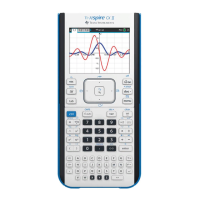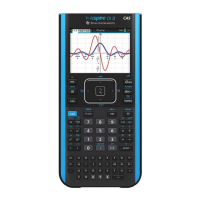TI-Nspire™ Reference Guide 95
SinReg
Catalog
>
SinReg X, Y [ , [Iterations] ,[ Period] [, Category, Include] ]
Computes the sinusoidal regression on lists X and Y. A summary of
results is stored in the stat.results variable. (See page 97.)
All the lists must have equal dimension except for Include.
X and Y are lists of independent and dependent variables.
Iterations is a value that specifies the maximum number of times (1
through 16) a solution will be attempted. If omitted, 8 is used.
Typically, larger values result in better accuracy but longer execution
times, and vice versa.
Period specifies an estimated period. If omitted, the difference
between values in X should be equal and in sequential order. If you
specify Period, the differences between x values can be unequal.
Category is a list of numeric or string category codes for the
corresponding X and Y data.
Include is a list of one or more of the category codes. Only those data
items whose category code is included in this list are included in the
calculation.
The output of SinReg is always in radians, regardless of the angle
mode setting.
For information on the effect of empty elements in a list, see “Empty
(void) elements” on page 131.
Output variable Description
stat.RegEqn Regression Equation: a·sin(bx+c)+d
stat.a, stat.b, stat.c,
stat.d
Regression coefficients
stat.Resid Residuals from the regression
stat.XReg List of data points in the modified X List actually used in the regression based on restrictions of Freq,
Category List, and Include Categories
stat.YReg List of data points in the modified Y List actually used in the regression based on restrictions of Freq,
Category List, and Include Categories
stat.FreqReg List of frequencies corresponding to stat.XReg and stat.YReg
SortA
Catalog
>
SortA List1[, List2] [, List3] ...
SortA
Vector1[, Vector2] [, Vector3] ...
Sorts the elements of the first argument in ascending order.
If you include additional arguments, sorts the elements of each so
that their new positions match the new positions of the elements in
the first argument.
All arguments must be names of lists or vectors. All arguments must
have equal dimensions.
Empty (void) elements within the first argument move to the bottom.
For more information on empty elements, see page 131.

